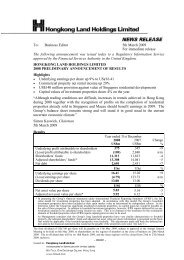Annual Report 2011 - Hongkong Land
Annual Report 2011 - Hongkong Land
Annual Report 2011 - Hongkong Land
You also want an ePaper? Increase the reach of your titles
YUMPU automatically turns print PDFs into web optimized ePapers that Google loves.
Notes to the Financial Statements<br />
1 Principal Accounting Policies<br />
Basis of preparation<br />
The financial statements have been prepared in accordance with International Financial <strong>Report</strong>ing Standards, including<br />
International Accounting Standards and Interpretations adopted by the International Accounting Standards Board. The financial<br />
statements have been prepared under the historical cost convention except as disclosed in the accounting policies below.<br />
Standards, amendments and interpretations effective in <strong>2011</strong> which are relevant to the Group’s operations<br />
Revised IAS 24<br />
Amendment to IAS 32<br />
Amendments to IFRIC 14<br />
IFRIC 19<br />
Improvements to IFRSs (2010)<br />
Related Party Disclosures<br />
Classification of Rights Issues<br />
Prepayments of a Minimum Funding Requirement<br />
Extinguishing Financial Liabilities with Equity Instruments<br />
The adoption of these standards, amendments and interpretations does not have a material impact on the Group’s<br />
accounting policies.<br />
Revised IAS 24 ‘Related Party Disclosures’ supersedes IAS 24 (as revised in 2003). It simplifies the disclosure requirements<br />
for government-related entities and clarifies the definition of a related party.<br />
Amendment to IAS 32 ‘Classification of Rights Issues’ clarifies that rights issues are equity instruments when they<br />
are denominated in a currency other than the issuer’s functional currency and are issued pro-rata to an entity’s existing<br />
shareholders for a fixed amount of currency.<br />
Amendments to IFRIC 14 ‘Prepayments of a Minimum Funding Requirement’ require an entity to recognise an asset for<br />
a prepayment that will reduce future minimum funding contributions required by the entity.<br />
IFRIC 19 ‘Extinguishing Financial Liabilities with Equity Instruments’ provides guidance on the application of IAS 39 and IAS 32<br />
when an entity issues its own equity instruments to extinguish all or part of a financial liability.<br />
The Improvements to IFRSs (2010) comprise a number of non-urgent but necessary amendments to IFRSs. The amendments<br />
which are relevant to the Group’s operations include IFRS 3 (amendments) ‘Business Combinations’, IFRS 7 (amendments)<br />
‘Financial Instruments: Disclosures’, IAS 1 (amendments) ‘Presentation of Financial Statements’, IAS 34 (amendments) ‘Interim<br />
Financial <strong>Report</strong>ing’ and IFRIC 13 (amendment) ‘Customer Loyalty Programmes’.<br />
IFRS 3 (amendments) ‘Business Combinations’ clarify the transition requirements for contingent consideration from business<br />
combination that occurred before the effective date of the revised IFRS, the measurement of non-controlling interests and<br />
un-replaced and voluntarily replaced share-based payment awards.<br />
IFRS 7 (amendments) ‘Financial Instruments: Disclosures’ emphasise the interaction between qualitative and quantitative<br />
disclosures and the nature and extent of risks associated with financial instruments.<br />
IAS 1 (amendments) ‘Presentation of Financial Statements’ clarify that entities may present the required reconciliations<br />
for each component of other comprehensive income either in the statement of changes in equity or in the notes to the<br />
financial statements.<br />
IAS 34 (amendments) ‘Interim Financial <strong>Report</strong>ing’ provide guidance to illustrate how to apply disclosure principles in IAS 34 and<br />
add disclosure requirements around the circumstances likely to affect fair values of financial instruments and their classification,<br />
transfers of financial instruments between different levels of fair value hierarchy, changes in classification of financial assets and<br />
changes in contingent liabilities and assets.<br />
IFRIC 13 (amendment) ‘Customer Loyalty Programmes’ clarifies that when the fair value of award credits is measured on the<br />
basis of the value of the awards for which they could be redeemed, the fair value of the award credits should take account of<br />
expected forfeitures as well as the discounts or incentives that would otherwise be offered to customers who have not earned<br />
award credits from an initial sale.<br />
<strong>Annual</strong> <strong>Report</strong> <strong>2011</strong> 25
















